Inpage Navigation Section: Overview
The Z spirit finds its latest expression in the Sugomi styled Z900. Power to the max, instinctive handling and traction control redefine the supernaked experience. LED lights and a TFT display bring the newest tech. Push boundaries and dominate your ride.
Colours
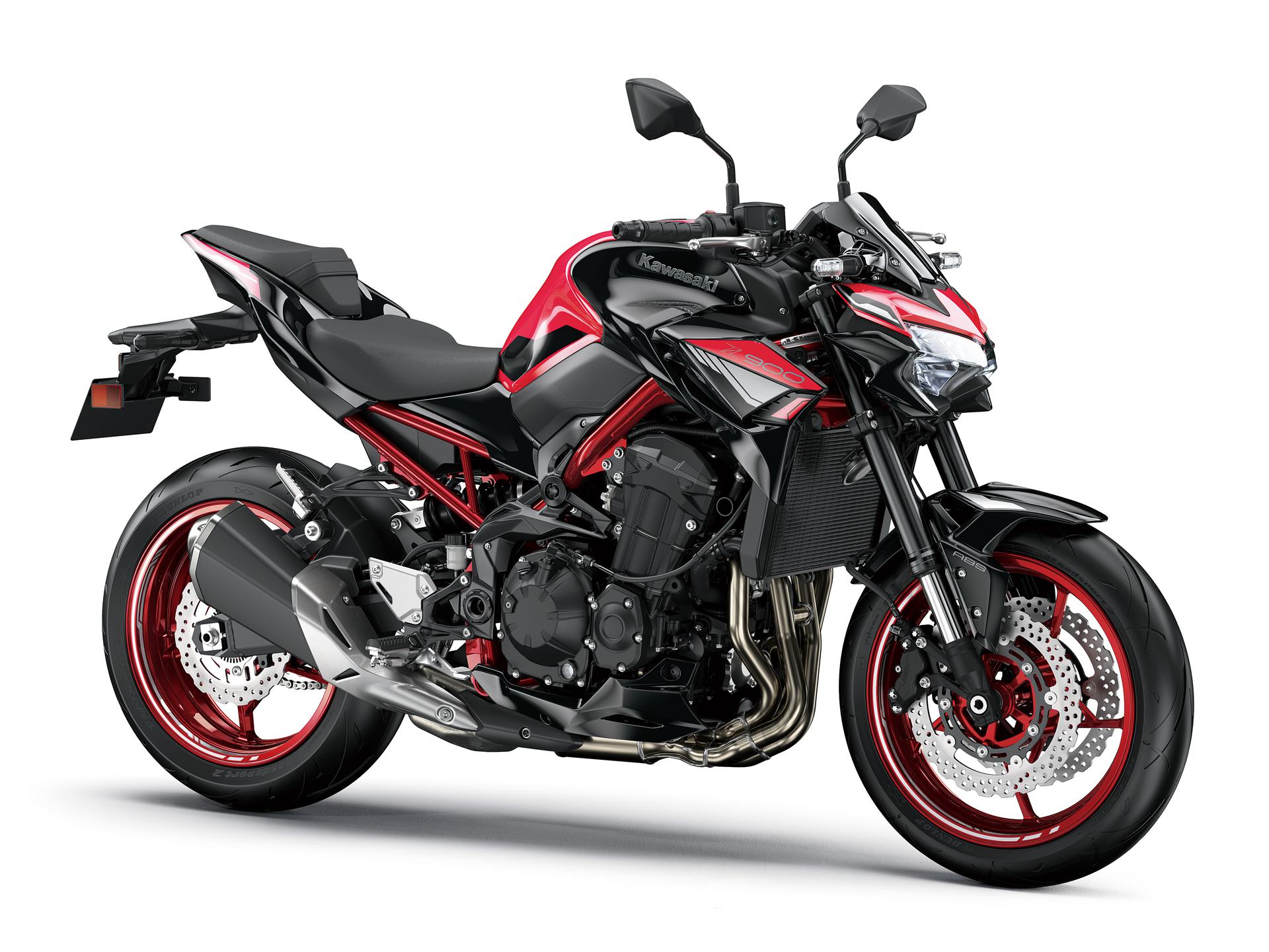
Show all
Show less
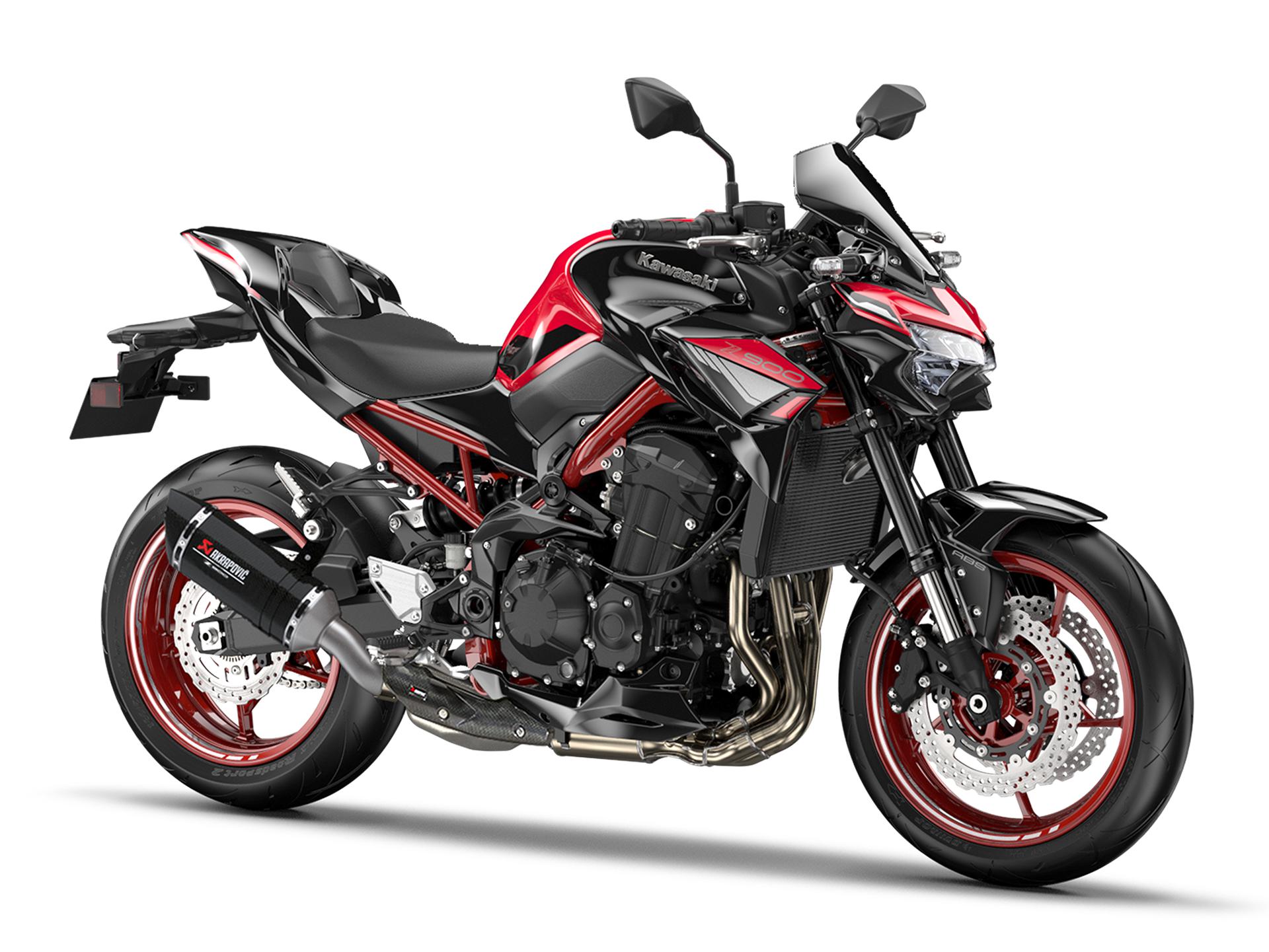
Edition Accessories
Show all
Show less
Inpage Navigation Section: Gallery
Inpage Navigation Section: Features & Specs
While the Z900’s distinctive sugomi design elements (crouching stance, low-positioned head and upswept tail) remain unchanged, its eye-catching styling benefits from a number of updates that make its aggressive design even sharper.

While the Z900’s distinctive sugomi design elements (crouching stance, low-positioned head and upswept tail) remain unchanged, its eye-catching styling benefits from a number of updates that make its aggressive design even sharper.
Kawasaki's advanced traction control system provides both enhanced sport riding performance and the peace of mind to negotiate low-traction surfaces with confidence. Three riderselectable modes offer progressively greater levels of intrusion to suit the riding situation and rider preference.

Kawasaki's advanced traction control system provides both enhanced sport riding performance and the peace of mind to negotiate low-traction surfaces with confidence. Three riderselectable modes offer progressively greater levels of intrusion to suit the riding situation and rider preference.
All-inclusive Riding modes that link KTRC and Power Mode allow riders to easily set traction control and power delivery to suit a given riding situation. Riders can choose from three settings (Sport, Road, Rain) or a manual setting (Rider). In the manual Rider mode, each of the systems can be set independently

All-inclusive Riding modes that link KTRC and Power Mode allow riders to easily set traction control and power delivery to suit a given riding situation. Riders can choose from three settings (Sport, Road, Rain) or a manual setting (Rider). In the manual Rider mode, each of the systems can be set independently
New LED headlamp, position lamps, licence plate lamp and turn signals† add to the Z900’s sharper new styling.

New LED headlamp, position lamps, licence plate lamp and turn signals† add to the Z900’s sharper new styling.
New Dunlop Sportmax Roadsport 2 tyres contribute to the Z900’s superb handling character.

New Dunlop Sportmax Roadsport 2 tyres contribute to the Z900’s superb handling character.
A Bluetooth technology built into the instrument panel enables riders to connect to their motorcycle wirelessly. Using the smartphone application “RIDEOLOGY THE APP,” a number of instrument functions can be accessed, contributing to an enhanced motorcycling experience.

A Bluetooth technology built into the instrument panel enables riders to connect to their motorcycle wirelessly. Using the smartphone application “RIDEOLOGY THE APP,” a number of instrument functions can be accessed, contributing to an enhanced motorcycling experience.
A choice of Full Power or Low Power modes allows riders to set power delivery to suit preference and conditions. Low Power mode limits output to approximately 55% of Full Power. (The reduced power, which varies according to engine speed (rpm) and throttle position, offers enhanced manageability.)

A choice of Full Power or Low Power modes allows riders to set power delivery to suit preference and conditions. Low Power mode limits output to approximately 55% of Full Power. (The reduced power, which varies according to engine speed (rpm) and throttle position, offers enhanced manageability.)
The new all-digital TFT colour instrumentation gives the cockpit a high-tech, high-grade appearance. The new meter also offers additional features unavailable on the previous model.

The new all-digital TFT colour instrumentation gives the cockpit a high-tech, high-grade appearance. The new meter also offers additional features unavailable on the previous model.
While the Z900’s distinctive sugomi design elements (crouching stance, low-positioned head and upswept tail) remain unchanged, its eye-catching styling benefits from a number of updates that make its aggressive design even sharper.

While the Z900’s distinctive sugomi design elements (crouching stance, low-positioned head and upswept tail) remain unchanged, its eye-catching styling benefits from a number of updates that make its aggressive design even sharper.
Kawasaki's advanced traction control system provides both enhanced sport riding performance and the peace of mind to negotiate low-traction surfaces with confidence. Three riderselectable modes offer progressively greater levels of intrusion to suit the riding situation and rider preference.

Kawasaki's advanced traction control system provides both enhanced sport riding performance and the peace of mind to negotiate low-traction surfaces with confidence. Three riderselectable modes offer progressively greater levels of intrusion to suit the riding situation and rider preference.
All-inclusive Riding modes that link KTRC and Power Mode allow riders to easily set traction control and power delivery to suit a given riding situation. Riders can choose from three settings (Sport, Road, Rain) or a manual setting (Rider). In the manual Rider mode, each of the systems can be set independently

All-inclusive Riding modes that link KTRC and Power Mode allow riders to easily set traction control and power delivery to suit a given riding situation. Riders can choose from three settings (Sport, Road, Rain) or a manual setting (Rider). In the manual Rider mode, each of the systems can be set independently
New LED headlamp, position lamps, licence plate lamp and turn signals† add to the Z900’s sharper new styling.

New LED headlamp, position lamps, licence plate lamp and turn signals† add to the Z900’s sharper new styling.
New Dunlop Sportmax Roadsport 2 tyres contribute to the Z900’s superb handling character.

New Dunlop Sportmax Roadsport 2 tyres contribute to the Z900’s superb handling character.
A Bluetooth technology built into the instrument panel enables riders to connect to their motorcycle wirelessly. Using the smartphone application “RIDEOLOGY THE APP,” a number of instrument functions can be accessed, contributing to an enhanced motorcycling experience.

A Bluetooth technology built into the instrument panel enables riders to connect to their motorcycle wirelessly. Using the smartphone application “RIDEOLOGY THE APP,” a number of instrument functions can be accessed, contributing to an enhanced motorcycling experience.
A choice of Full Power or Low Power modes allows riders to set power delivery to suit preference and conditions. Low Power mode limits output to approximately 55% of Full Power. (The reduced power, which varies according to engine speed (rpm) and throttle position, offers enhanced manageability.)

A choice of Full Power or Low Power modes allows riders to set power delivery to suit preference and conditions. Low Power mode limits output to approximately 55% of Full Power. (The reduced power, which varies according to engine speed (rpm) and throttle position, offers enhanced manageability.)
The new all-digital TFT colour instrumentation gives the cockpit a high-tech, high-grade appearance. The new meter also offers additional features unavailable on the previous model.

The new all-digital TFT colour instrumentation gives the cockpit a high-tech, high-grade appearance. The new meter also offers additional features unavailable on the previous model.
Smartphone connectivity contributes to an enhanced motorcycling experience by enabling riders to connect to their motorcycle wirelessly.
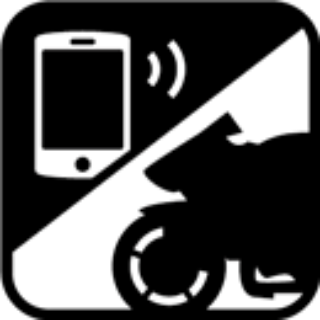
Clever technology enables riders to connect to their motorcycle wirelessly. Using the smartphone application RIDEOLOGY THE APP a number of instrument functions can be accessed, contributing to an enhanced motorcycling experience. Vehicle information (such as the odometer, fuel gauge, maintenance schedule, etc) can be viewed on the smartphone. Riding logs (varies by model, but may include GPS route, gear position, rpm, and other information) can be viewed on the smartphone. When connected, telephone (call, mail) notices are displayed on the instrument panel. Riders can also make changes to their motorcycle instrument display settings (preferred units, clock and date setting, etc) via the smartphone. And on certain models, it is even possible to check and adjust vehicle settings (such as Rider Mode, electronic rider support features, and payload settings) using the smartphone.
3-Mode KTRC (Kawasaki TRaction Control), Kawasaki's most advanced traction control system, offers a selection of modes to suit a variety of riding situations, from sport riding to touring.

3-mode KTRC combines the traction control technology of both 1-mode KTRC, which provides enhanced stability in slippery situations by preventing wheel slip, and S-KTRC, which helps maintain optimum traction in sport riding situations by predicting the rear wheel slip ratio during acceleration, into a single system. The convenient handle switch allows the type of traction control to be changed instantly by selecting one of the three modes, even while riding. Modes 1 and 2 maintain optimum traction during cornering, like S-KTRC. Designed with sport riding in mind, they enable sharp acceleration out of corners by maximizing forward drive from the rear wheel. Modes 1 and 2 differ in the amount that they intervene. Mode 1, set for dry, good-grip road conditions, maintains the ideal slip ratio to ensure optimum traction. Mode 3 operates like 1-mode KTRC, reducing power to allow grip to be regained when rear wheel spin is detected. It is ideal when riding in slippery conditions or in the wet. Enabling riders to easily change traction control character, 3-mode KTRC is Kawasaki's most advanced engine management system.
Based on racing technology, the Assist & Slipper Clutch acts as both a back-torque limiter and a self-servo mechanism that enables a lighter clutch lever pull.

Based on feedback from racing activities, the Assist & Slipper Clutch uses two types of cams (an assist cam and a slipper cam) to either drive the clutch hub and operating plate together or apart. Under normal operation, the assist cam functions as a self-servo mechanism, pulling the clutch hub and operating plate together to compress the clutch plates. This allows the total clutch spring load to be reduced, resulting in a lighter clutch lever feel when operating the clutch. When excessive engine braking occurs as a result of quick downshifts (or an accidental downshift) the slipper cam comes into play, forcing the clutch hub and operating plate apart. This relieves pressure on the clutch plates to reduce back-torque and helps prevent the rear tyre from hopping and skidding. This race-style function is particularly useful when sport or track riding.
Dual Throttle Valves offer increased power and greater ease of use care of a second set of ECU-controlled throttle valves.

Late-model sport bikes often use large-bore throttle bodies to generate high levels of power. However, with large diameter throttles, when a rider suddenly opens the throttle, the unrestricted torque response can be strong. Dual throttle valve technology was designed to tame engine response while contributing to performance.
On models with dual throttle valves, there are two throttle valves per cylinder: in addition to the main valves, which are physically linked to the throttle grip and controlled by the rider, a second set of valves, opened and closed by the ECU, precisely regulates intake airflow to ensure a natural, linear response. With the air passing through the throttle bodies becoming smoother, combustion efficiency in improved and power is increased.
Horizontal Back-link Rear Suspension arranges its shock unit horizontally, greatly contributing to efficient use of space and mass centralisation.

Compared to Kawasaki's traditional Uni-Trak rear suspension, which mounts the shock unit vertically, with Horizontal Back-link rear suspension, the shock unit is almost horizontal. Kawasaki's original suspension arrangement locates the shock unit very close to the bike's centre of gravity, greatly contributing to mass centralisation. And because there is no linkage or shock unit protruding beneath the swingarm, this frees up space for a larger exhaust pre-chamber (an exhaust expansion chamber situated just upstream of the silencer). With a larger pre-chamber, silencer volume can be reduced, and heavy exhaust components can be concentrated closer to the centre of the bike, further contributing to mass centralisation. The result is greatly improved handling. Another benefit is that the shock unit is placed far away from exhaust heat. Because it is more difficult for heat from the exhaust system to adversely affect suspension oil and gas pressure, suspension performance is more stable. Horizontal Back-link rear suspension offers numerous secondary benefits like this.
Power Mode selection allows engine power delivery to be changed to suit the riding situation.
Models equipped with multiple Power Modes offer riders an easily selectable choice of engine power delivery to suit riding conditions or preference. In addition to Full Power mode, one (Low) or two (Middle, Low) alternate mode(s) in which maximum power is limited and throttle response is milder are provided.
The Economical Riding Indicator is a mark appearing on the instrument panel to indicate favourable fuel consumption, encouraging fuel efficient riding.

Using high-precision electronic control for engine management, Kawasaki models can achieve a high level of fuel efficiency. However, fuel consumption is greatly affected by throttle use, gear selection, and other elements under the rider's control. The Economical Riding Indicator is a function that indicates when current riding conditions are consuming a low amount of fuel. The system continuously monitors fuel consumption, regardless of vehicle speed, engine speed, throttle position and other riding conditions. When fuel consumption is low for a given speed (i.e. fuel efficiency is high), an "ECO" mark appears on the instrument panel's LCD screen. By riding so that the "ECO" mark remains on, fuel consumption can be reduced. While effective vehicle speed and engine speed may vary by model, paying attention to conditions that cause the "ECO" mark to appear can help riders improve their fuel efficiency – a handy way to increase cruising range. Further, keeping fuel consumption low also helps minimise negative impact on the environment.
ABS (Anti-lock Brake System) ensures stable braking performance by preventing wheel lock during braking.

Sudden over-application of the brakes, or braking on low-grip surfaces (surfaces with a low coefficient of friction) such as wet asphalt or manhole covers may cause a motorcycle's wheel(s) to lock up and slip. ABS was developed to prevent such incidents. Kawasaki ABS systems are controlled by high precision and highly reliable programming formulated based on thorough testing of numerous riding situations. By ensuring stable braking performance, they offer rider reassurance that contributes to greater riding enjoyment. And to meet the special requirements of certain riders, specialised ABS systems are also available. For example, KIBS (Kawasaki Intelligent anti-lock Brake System) is a high-precision brake system designed specifically for supersport models, enabling sport riding to be enjoyed by a wider range of riders. And by linking the front and rear brakes, K-ACT (Kawasaki Advanced Coactive-braking Technology) ABS provides the confidence to enjoy touring on heavyweight models. Kawasaki is continually working on the development of other advanced ABS systems.
Smartphone connectivity contributes to an enhanced motorcycling experience by enabling riders to connect to their motorcycle wirelessly.

Clever technology enables riders to connect to their motorcycle wirelessly. Using the smartphone application RIDEOLOGY THE APP a number of instrument functions can be accessed, contributing to an enhanced motorcycling experience. Vehicle information (such as the odometer, fuel gauge, maintenance schedule, etc) can be viewed on the smartphone. Riding logs (varies by model, but may include GPS route, gear position, rpm, and other information) can be viewed on the smartphone. When connected, telephone (call, mail) notices are displayed on the instrument panel. Riders can also make changes to their motorcycle instrument display settings (preferred units, clock and date setting, etc) via the smartphone. And on certain models, it is even possible to check and adjust vehicle settings (such as Rider Mode, electronic rider support features, and payload settings) using the smartphone.
3-Mode KTRC (Kawasaki TRaction Control), Kawasaki's most advanced traction control system, offers a selection of modes to suit a variety of riding situations, from sport riding to touring.

3-mode KTRC combines the traction control technology of both 1-mode KTRC, which provides enhanced stability in slippery situations by preventing wheel slip, and S-KTRC, which helps maintain optimum traction in sport riding situations by predicting the rear wheel slip ratio during acceleration, into a single system. The convenient handle switch allows the type of traction control to be changed instantly by selecting one of the three modes, even while riding. Modes 1 and 2 maintain optimum traction during cornering, like S-KTRC. Designed with sport riding in mind, they enable sharp acceleration out of corners by maximizing forward drive from the rear wheel. Modes 1 and 2 differ in the amount that they intervene. Mode 1, set for dry, good-grip road conditions, maintains the ideal slip ratio to ensure optimum traction. Mode 3 operates like 1-mode KTRC, reducing power to allow grip to be regained when rear wheel spin is detected. It is ideal when riding in slippery conditions or in the wet. Enabling riders to easily change traction control character, 3-mode KTRC is Kawasaki's most advanced engine management system.
Based on racing technology, the Assist & Slipper Clutch acts as both a back-torque limiter and a self-servo mechanism that enables a lighter clutch lever pull.

Based on feedback from racing activities, the Assist & Slipper Clutch uses two types of cams (an assist cam and a slipper cam) to either drive the clutch hub and operating plate together or apart. Under normal operation, the assist cam functions as a self-servo mechanism, pulling the clutch hub and operating plate together to compress the clutch plates. This allows the total clutch spring load to be reduced, resulting in a lighter clutch lever feel when operating the clutch. When excessive engine braking occurs as a result of quick downshifts (or an accidental downshift) the slipper cam comes into play, forcing the clutch hub and operating plate apart. This relieves pressure on the clutch plates to reduce back-torque and helps prevent the rear tyre from hopping and skidding. This race-style function is particularly useful when sport or track riding.
Dual Throttle Valves offer increased power and greater ease of use care of a second set of ECU-controlled throttle valves.

Late-model sport bikes often use large-bore throttle bodies to generate high levels of power. However, with large diameter throttles, when a rider suddenly opens the throttle, the unrestricted torque response can be strong. Dual throttle valve technology was designed to tame engine response while contributing to performance.
On models with dual throttle valves, there are two throttle valves per cylinder: in addition to the main valves, which are physically linked to the throttle grip and controlled by the rider, a second set of valves, opened and closed by the ECU, precisely regulates intake airflow to ensure a natural, linear response. With the air passing through the throttle bodies becoming smoother, combustion efficiency in improved and power is increased.
Horizontal Back-link Rear Suspension arranges its shock unit horizontally, greatly contributing to efficient use of space and mass centralisation.

Compared to Kawasaki's traditional Uni-Trak rear suspension, which mounts the shock unit vertically, with Horizontal Back-link rear suspension, the shock unit is almost horizontal. Kawasaki's original suspension arrangement locates the shock unit very close to the bike's centre of gravity, greatly contributing to mass centralisation. And because there is no linkage or shock unit protruding beneath the swingarm, this frees up space for a larger exhaust pre-chamber (an exhaust expansion chamber situated just upstream of the silencer). With a larger pre-chamber, silencer volume can be reduced, and heavy exhaust components can be concentrated closer to the centre of the bike, further contributing to mass centralisation. The result is greatly improved handling. Another benefit is that the shock unit is placed far away from exhaust heat. Because it is more difficult for heat from the exhaust system to adversely affect suspension oil and gas pressure, suspension performance is more stable. Horizontal Back-link rear suspension offers numerous secondary benefits like this.
Power Mode selection allows engine power delivery to be changed to suit the riding situation.
Models equipped with multiple Power Modes offer riders an easily selectable choice of engine power delivery to suit riding conditions or preference. In addition to Full Power mode, one (Low) or two (Middle, Low) alternate mode(s) in which maximum power is limited and throttle response is milder are provided.
The Economical Riding Indicator is a mark appearing on the instrument panel to indicate favourable fuel consumption, encouraging fuel efficient riding.

Using high-precision electronic control for engine management, Kawasaki models can achieve a high level of fuel efficiency. However, fuel consumption is greatly affected by throttle use, gear selection, and other elements under the rider's control. The Economical Riding Indicator is a function that indicates when current riding conditions are consuming a low amount of fuel. The system continuously monitors fuel consumption, regardless of vehicle speed, engine speed, throttle position and other riding conditions. When fuel consumption is low for a given speed (i.e. fuel efficiency is high), an "ECO" mark appears on the instrument panel's LCD screen. By riding so that the "ECO" mark remains on, fuel consumption can be reduced. While effective vehicle speed and engine speed may vary by model, paying attention to conditions that cause the "ECO" mark to appear can help riders improve their fuel efficiency – a handy way to increase cruising range. Further, keeping fuel consumption low also helps minimise negative impact on the environment.
ABS (Anti-lock Brake System) ensures stable braking performance by preventing wheel lock during braking.

Sudden over-application of the brakes, or braking on low-grip surfaces (surfaces with a low coefficient of friction) such as wet asphalt or manhole covers may cause a motorcycle's wheel(s) to lock up and slip. ABS was developed to prevent such incidents. Kawasaki ABS systems are controlled by high precision and highly reliable programming formulated based on thorough testing of numerous riding situations. By ensuring stable braking performance, they offer rider reassurance that contributes to greater riding enjoyment. And to meet the special requirements of certain riders, specialised ABS systems are also available. For example, KIBS (Kawasaki Intelligent anti-lock Brake System) is a high-precision brake system designed specifically for supersport models, enabling sport riding to be enjoyed by a wider range of riders. And by linking the front and rear brakes, K-ACT (Kawasaki Advanced Coactive-braking Technology) ABS provides the confidence to enjoy touring on heavyweight models. Kawasaki is continually working on the development of other advanced ABS systems.
| Engine type | Liquid-cooled, 4-stroke, in-line four |
|---|---|
| Compression ratio | 11.8:1 |
| Valve system | DOHC, 16 valves |
| Bore x stroke | 73.4 x 56.0 mm |
| Displacement | 948 cm³ |
| Fuel system | Fuel injection with sub-throttles: 36 mm x 4 |
| Lubrication | Forced lubrication, wet sump |
| Starting system | Electric |
| Ignition system | Digital |
| Maximum power | 92.2 kW {125 PS} / 9,500 rpm |
|---|---|
| Maximum torque | 98.6 N•m {9.9 kgf•m} / 7,700 rpm |
| CO2 emission | 132 g/km |
| Fuel consumption | 5.7 l/100km |
| CO2 emission 85 kW kit | 132.0 g/km |
| Fuel consumption 85 kW kit | 5.7 l/100km |
| Transmission | 6-speed, return shift |
| Clutch | Wet, multi disc |
| Primary reduction ratio | 1.627 (83/51) |
| Gear ratios 1st | 2.692 (35/13) |
| Gear ratios 2nd | 2.059 (35/17) |
| Gear ratios 3rd | 1.650 (33/20) |
| Gear ratios 4th | 1.409 (31/22) |
| Gear ratios 5th | 1.222 (33/27) |
| Gear ratios 6th | 1.034 (30/29) |
| Final drive | Sealed chain |
| Final reduction ratio | 2.933 (44/15) |
| Frame type | Trellis, high-tensile steel |
|---|---|
| Trail | 110 mm |
| Wheel travel front | 120 mm |
| Wheel travel rear | 140 mm |
| Tyre, front | 120/70 ZR17 M/C (58W) |
| Tyre, rear | 180/55 ZR17 M/C (73W) |
| L x W x H | 2,070 x 825 x 1,080 mm |
| Steering angle L/R | 33° / 33° |
| Wheel base | 1,455 mm |
| Ground clearance | 145 mm |
| Fuel capacity | 17.0 litres |
| Seat height | 820 mm |
| Curb mass | 212 kg |
| Front brake type | Dual semi-floating petal discs |
|---|---|
| Front brake diameter | Ø 300 mm |
| Front brake caliper type | Opposed 4-piston |
| Rear brake type | Single petal disc |
| Rear brake diameter | Ø 250 mm |
| Rear brake caliper type | Single-piston |
| Front suspension type | Inverted fork with rebound damping, and spring preload adjustability |
| Front suspension diameter | Ø 41 mm |
| Rear suspension type | Horizontal Back-link, gas-charged shock, rebound damping, and spring preload adjustability |
Inpage Navigation Section: Accessories

Strong durable multi layered fabric with taped seams. Heat resistant honeycomb till 120 degrees Celcius. Subtle Branding.
100% Polyester. With multi usable packing backpack.
(XL + top case cover has extra compartment that can be zipped open to make room for top case)
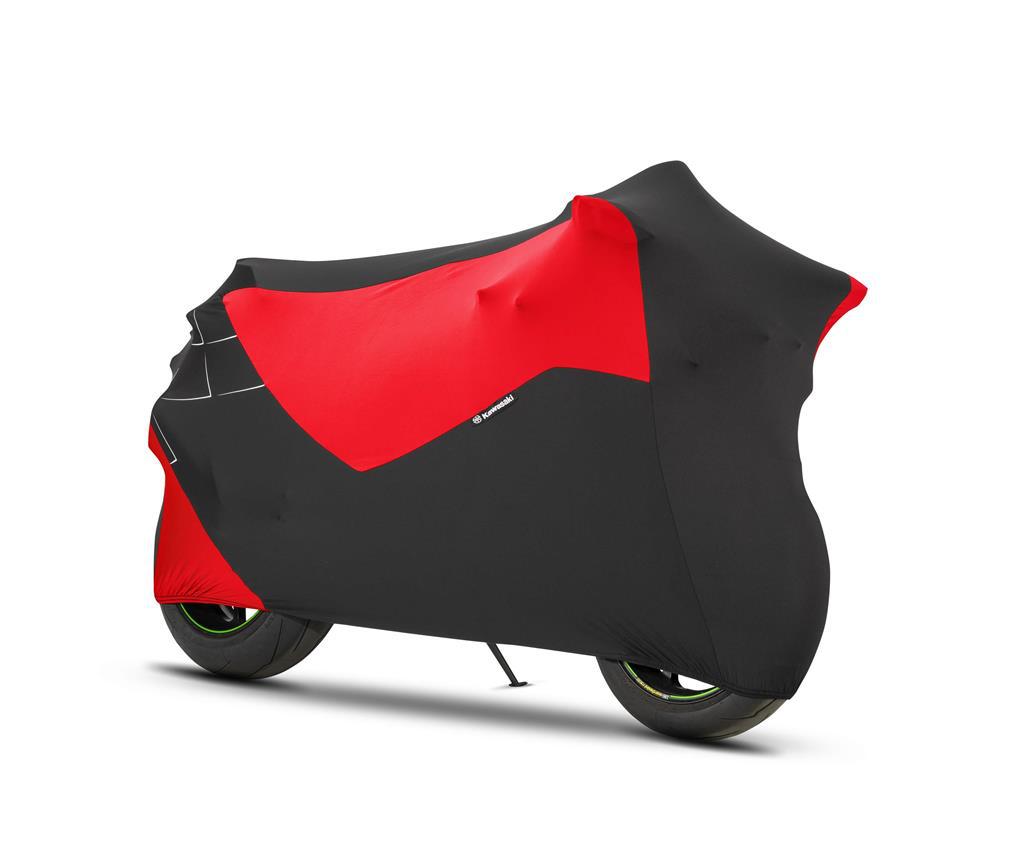
4-Way super stretch material. Reinforced bottom. Available in Green-Black and Red-Black
Read MoreThe Slip-On Line represents the first step in exhaust tuning and gives a performance increase to the Z900. It has a smaller, shorter, conical design, all aimed at improving the bike’s appearance.
It is manufactured from high-grade lightweight titanium, offering a big weight savings over the stock muffler, and is finished with a hand-built carbon-fibre endcap to add to the looks and desirability. It delivers an enriched sound for enhanced enjoyment.
Meeting EC/ECE type approval this exhaust is an easy upgrade designed to improve the bike’s performance.
Carbon heatshield is sold separately.
Developed in conjuction wih SP Connect the kit consists of a Clutch Mount, Anti-vibration module and a Universal Phone Clamp. Suits mosts mobile phones; Simply pull out the crown, screw it tight, and then push the crown back in to lock your phone in place. While remaining fully operable, your phone can now be attached to or detached from the mount in seconds.
Larger Meter Cover raises airflow from the front cowl while maintaining an overall aggressive appearance.
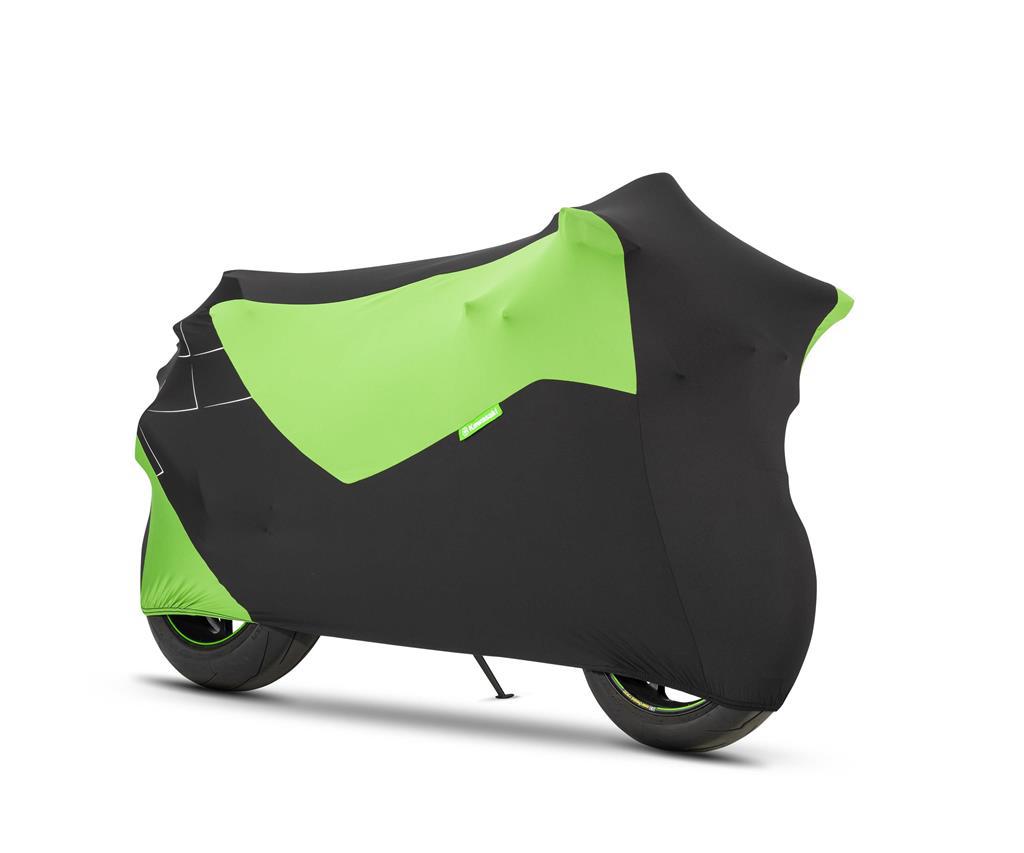
4-Way super stretch material. Reinforced bottom. Available in Green-Black and Red-Black
Read MoreThe Slip-On Line represents the first step in exhaust tuning and gives a performance increase to the Z900. It has a smaller, shorter, conical design, all aimed at improving the bike’s appearance. It is manufactured from high-grade lightweight titanium, offering a big weight savings over the stock muffler, and is finished with a hand-built carbon-fibre endcap to add to the looks and desirability. It delivers an enriched sound for enhanced enjoyment. Meeting EC/ECE type approval this exhaust is an easy upgrade designed to improve the bike’s performance. Carbon heatshield is not included.
Help protect your engine cases from tip over damage.
Help protect your motorcycle from tip-over damage.
Manufactured from durable ABS nylon, the functional yet stylish and compact design of this Front Axle Slider adds an extra level of protection to the motorcycle, and helps guard the forks from possible tip-over damage.
Semi rigid Nylon tank bag specially designed for the fuel tank shape.
Black/Grey tank bag with reflective piping and Kawasaki logo.
Pocket with transparent plastic window at top of tank bag with hole for earphone.
Inside has partitions to prevent goods moving around.
Including shoulder belt and rain cover with transparent window.
L350mm, W223mm,H150mm
Load Weight Max 2kg
Load Capacity approximate 4 Litre.
A matching bracket is required for fitment.
Whether you want to park your bike in a pitbox or in your garage, let your precious machine rest in style on this Kawasaki Garage Mat. The mat meets new FIM environmental codes and offers a high level of absorption and dust-control features.
Discover your next adventure
Ride challenge level. Plan windy and hilly roads
Discover the world's best curated riding routes, exclusively
Updates via Wi-Fi®. No computer needed
Discover, personalize and enjoy stunning riding routes with MyDrive
Compatible with Siri and Google Now™
Smartphone messages read aloud, hands-free calling
Lifetime* Worldwide Maps, TomTom Traffic and Services
Double the processing speed and five times faster start-up

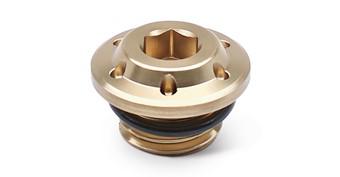
CNC machined billet aluminium Oil Filler Cap with gold finish Note: Compatibility and availability of accessories may vary per specific model year, please check with your Kawasaki Dealer on availability and additional parts needed for installation
Read More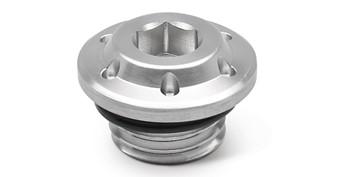
An essential tool for motorcycle enthusiasts and mechanics alike. Designed to provide stability and convenience, this paddock stand allows easy access to the wheels, suspension, and other components.
This premium rear bike stand can be disassembled, making transportation a lot easier. The compact bike stand comes in a shop worthy carrying case with a built-in carrying handle. The stand is made of premium steel and has a green and black finish. The Kawasaki logo is laser cut in steel.
Optional are the forks to suit your preference;
